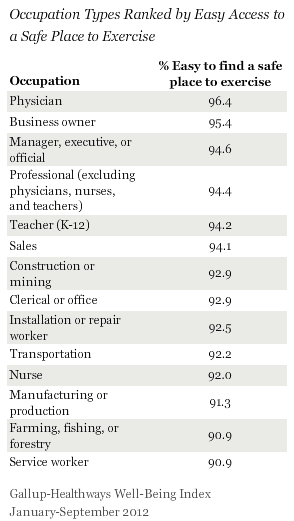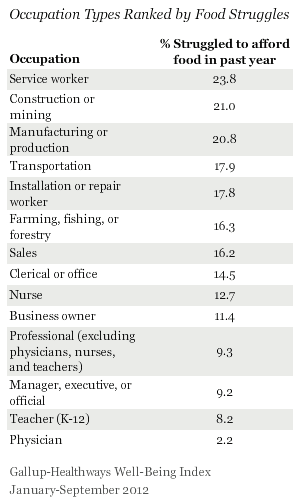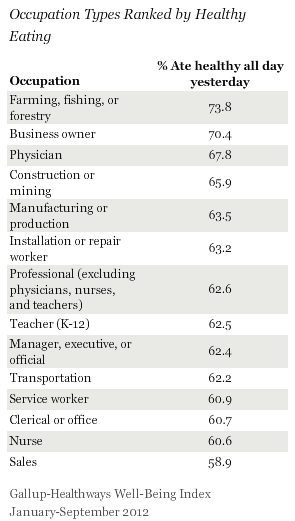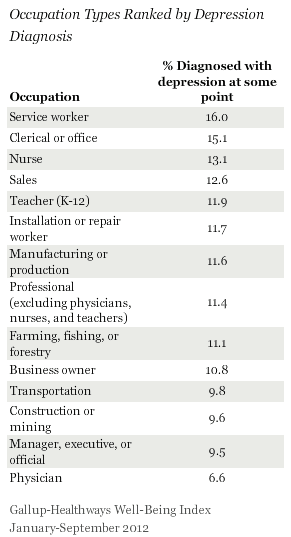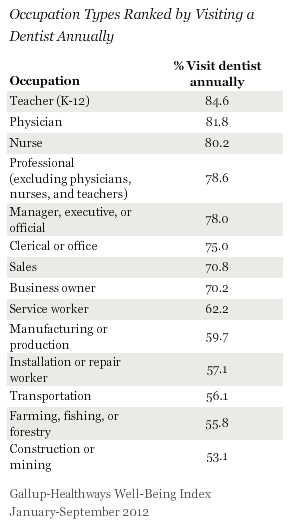WASHINGTON, D.C. -- For U.S. workers, exercising fewer than three days a week is more closely linked being obese -- defined as having a Body Mass Index of 30 or higher-- than any of 26 other behavioral and emotional factors, including healthy eating and having health insurance. This Gallup analysis of the correlates of obesity is based on interviews with more than 139,000 American workers. It also finds that not eating healthy, not having enough money to buy food, not having a safe place to exercise, having a history of depression, and not visiting a dentist annually are all linked to U.S. workers being obese.
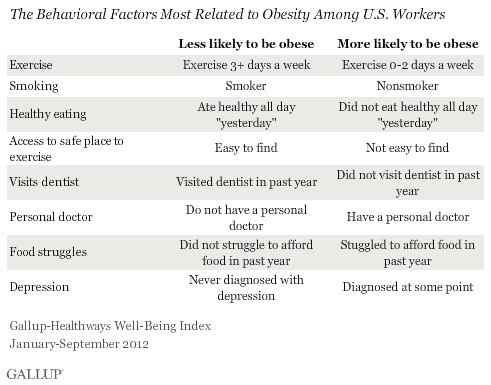
The analysis shows that not smoking and having a personal doctor were also moderate predictors of obesity among U.S. workers. Studies have shown that nicotine is an appetite suppressant, which is one explanation for why workers who smoke are less likely to be obese. Still, the negative health effects from smoking arguably outweigh any healthy weight benefits. Having a personal doctor may be positively related to obesity among workers because obese individuals are more likely than non-obese individuals to suffer from chronic conditions that would require them to have a personal doctor.
The findings are based on data collected as part of the Gallup-Healthways Well-Being Index from Jan. 2-Sept. 10, 2012. Gallup calculates respondents' BMI using the standard formula based on their self-reported height and weight. The analysis estimated the relationship between workers' obesity and each of 27 behavioral and emotional factors while controlling for age, ethnicity, race, marital status, gender, income, education, region, and religiosity.
The analysis finds that other behavioral and emotional factors, including high life ratings; feeling well-rested; and emotions including worry, sadness, stress, anger, and happiness, were not strongly or moderately related to obesity among U.S. workers after controlling for demographic variables. In addition, job satisfaction; using one's strengths at work; having health insurance; having enough money for healthcare; and having easy access to clean water, fruits, and vegetables were not strongly or moderately related to obesity among the U.S. workforce. These findings are consistent with Gallup's previous research on the factors most related to having a low or high BMI among national adults.
Transportation workers have the highest obesity rate among the 14 occupation groups measured, followed by manufacturing and production workers. Physicians have, by far, the lowest level of obesity, with business owners coming in second-lowest. These findings are consistent with what Gallup has previously found.
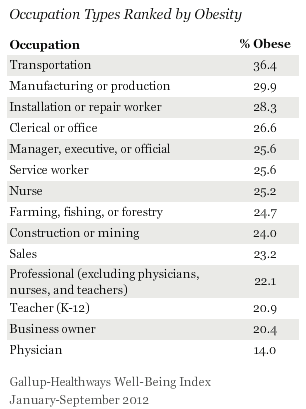
Physicians Do Best on Most Predictors of Obesity; Service Workers Do Worst
Highlights from how the 14 occupation groups perform on the strongest behavioral predictors of obesity among U.S. workers include:
- Physicians: This group boasts the lowest obesity rate and is in the best shape of all job types on three of the major predictors of obesity -- having a safe place to exercise, the ability to afford food, and depression.
- Service workers: These workers perform worst on two of the predictors of obesity: struggling to afford food and depression, and tie with farmers as the worst job type for having a safe place to exercise.
- Farming, fishing, and forestry workers: This group performs best on two of the top predictors of obesity -- healthy eating and exercise, which is likely due to the physical nature of their work. At the same time, they are tied with service workers as the worst job type for having easy access to a safe place to exercise, which may be due to having an outdoor work environment that could be dangerous.
- Other worst performers: Clerical or office workers are the least likely to exercise frequently, sales workers are the least likely to eat healthy, and construction or mining workers are the least likely to visit the dentist annually.
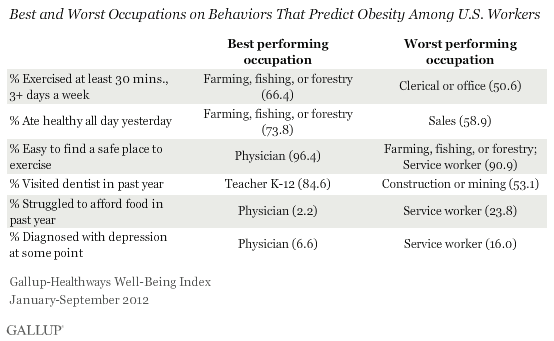
See full results for how all occupation groups perform on the predictors of obesity on page 2.
Implications
One in four U.S. workers is obese, which has tremendous costs for employers due to increased healthcare costs, higher absenteeism, and lower productivity. The medical costs in 2008 for obese individuals were $1,429 higher than for those of normal weight, according to the CDC. Gallup found that the annual cost for lost productivity due to workers being above normal weight or having a history of chronic conditions ranges from $160 million among agricultural workers to $24.2 billion among professionals.
Employers can cut their healthcare costs and improve their bottom line by developing targeted interventions, particularly by focusing on improving the behaviors linked to obesity that their occupation group struggles with most. To reduce the costs associated with obesity, employers can start by helping employees improve on the behavior with the strongest link to obesity -- infrequent exercise. Employers can consider opening an office gym or offering gym membership discounts to incentivize frequent exercise and provide a safe place for employees to work out. Gallup research also finds that engaged employees exercise more frequently and also eat healthier than those who are not engaged or are actively disengaged. Therefore, employers who prioritize employee engagement may see a double benefit of healthier and happier workers.
There are plenty of other ways employers in specific industries can improve their employees' health. For example, employers in the service industry -- the group which struggles most with affording food and with diagnoses of depression -- could develop discount programs to make healthy food more affordable for their employees and could make confidential depression screenings and resources readily available. Construction and mining industry employers could design an outreach campaign to encourage their workers to visit the dentist annually, offering incentives to those who do so.
These targeted, occupation-specific interventions have the potential to lead to tremendous cost-savings for workers, employers, and the U.S. economy.
About the Gallup-Healthways Well-Being Index
The Gallup-Healthways Well-Being Index tracks well-being in the U.S. and provides best-in-class solutions for a healthier world. To learn more, please visit well-beingindex.com.
Survey Methods
Results are based on telephone interviews conducted as part of the Gallup-Healthways Well-Being Index survey with a random sample of 138,438 workers, aged 18 or over, from Jan. 2-Sept. 10, 2012.
For results based on the total sample of employed adults, one can say with 95% confidence that the margin of sampling error is less than ±1 percentage point. For the smallest group (physicians) the margin of sampling error is ±3.7 percentage points but less than ±1 for larger groups such as professionals and service workers.
Interviews are conducted with respondents on landline telephones and cellular phones, with interviews conducted in Spanish for respondents who are primarily Spanish-speaking. Each sample includes a minimum quota of 400 cellphone respondents and 600 landline respondents per 1,000 national adults, with additional minimum quotas among landline respondents by region. Landline telephone numbers are chosen at random among listed telephone numbers. Cellphone numbers are selected using random-digit-dial methods. Landline respondents are chosen at random within each household on the basis of which member had the most recent birthday.
Samples are weighted by gender, age, race, Hispanic ethnicity, education, region, adults in the household, and phone status (cell phone only/landline only/both, cell phone mostly, and having an unlisted landline number). Demographic weighting targets are based on the March 2011 Current Population Survey figures for the aged 18 and older non-institutionalized population living in U.S. telephone households. All reported margins of sampling error include the computed design effects for weighting.
In addition to sampling error, question wording and practical difficulties in conducting surveys can introduce error or bias into the findings of public opinion polls.
For more details on Gallup's polling methodology, visit www.gallup.com.

